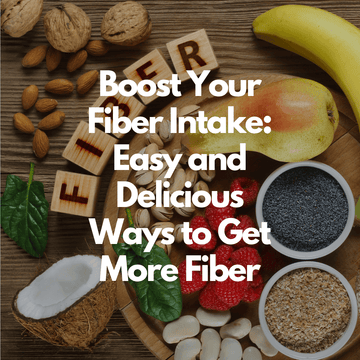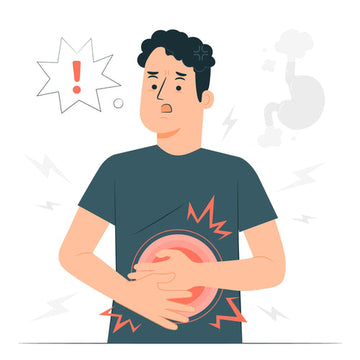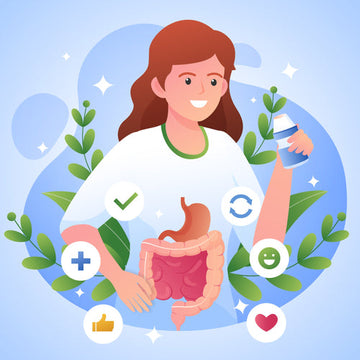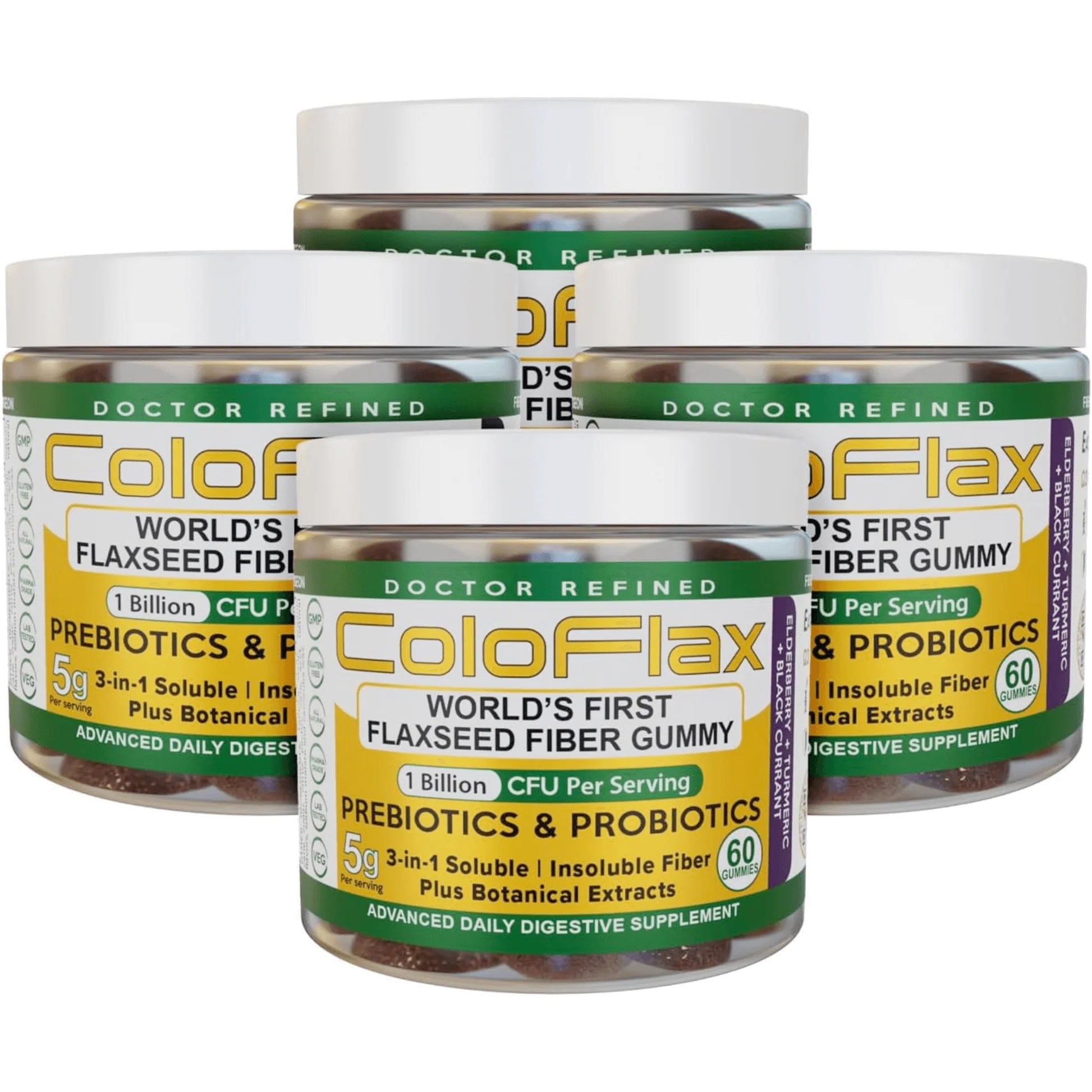Most of us can benefit from eating more vegetables. They are rich in nutrients and fiber and provide a host of health benefits. But what if you hate them? How can you possibly get enough fiber when the thought of steamed broccoli makes you vomit?
Well, while the best solution is to incorporate small amounts of vegetables where possible, there are other solutions for getting your fiber fix:
Take a Fiber Gummy
You might be averse to the savory and slightly bitter flavors of broccoli, but surely you don’t have anything against a sweet and chewy gummy?
The ColoFlax Flaxseed Fiber Gummy is a one-dose-a-day gummy that tastes great and provides a whopping 5 grams of fiber.
Unlike many other fiber supplements, the fiber contained in ColoFlax comes from high-quality sources and also features a blend of antioxidants, prebiotics, and probiotics.
Just as importantly, the fiber is a mixture of soluble and insoluble—it’s the best dose of fiber you’ll get all day.
Obviously, 5g isn’t enough to meet your daily needs. It can still make a massive difference to your overall digestive health, but if you’re still falling short of your daily requirements, try some of the options outlined below.
Switch to Whole Grains
An 80-calorie slice of wholegrain bread has around 3g of fiber. White bread, on the other hand, has less than 1g.
Bread is a popular choice among veg-haters, and if you eat 4 slices a day (such as 2 slices of toast and 1 sandwich), you’ll get an extra 8g of fiber.
That’s nearly a third of your recommended intake, and that’s just one minor change.
If you switch to wholegrain cereals and wholewheat pasta, you can add several more grams of fiber to your daily intake without feeling like you’re doing anything.
Eat More Fruit
In our guide to the healthiest fruits, we highlighted the most nutrient-dense and fiber-rich fruits out there, showing you just how much of a difference these foods can make to your health.
For example, a 65-calorie serving of raspberries contains 8g of fiber, and it’s a similar story with blackberries and blueberries. Not only are these berries rich in antioxidants and vitamins, but one handful will give you the same amount of fiber as two cups of cooked oatmeal.
Not a fan of tart blackberries? Can’t find high-quality raspberries where you live? There are many other great options. Passionfruit, persimmons, pomegranates, and apples are also high in fiber.
Several servings of fruit a day are usually enough to meet your fiber needs. And if that still doesn’t appeal, try dried fruit instead. Although high in sugar and calories, dried cherries, figs, and apricots are great sources of fiber, as are prunes, raisins, and many other dried fruits.
Try Chia Seeds and Flaxseeds
We have already devoted a lot of blog space to praising flaxseeds and chia seeds, and not without reason. A 160-calorie serving of flaxseeds contains nearly 10g of protein and 5g of fiber while chia seeds have 10g of fiber and 5g of protein.
These seeds are versatile and can be added to smoothies, breakfast bowls, desserts, yogurts, oatmeal, salads, and more. A tablespoon a day can make a massive difference to your digestive health.
In addition to providing plenty of protein and fiber, these seeds are high in healthy fats (including omega-3 fatty acids), amino acids, B vitamins, minerals, and antioxidants.
Hemp seeds are also beneficial, but at just 2g fiber for a 160-calorie serving, they’re not the best for increasing your fiber intake.
Eat Some Popcorn
Popcorn has a pretty bad reputation. It’s junk food, something that you eat mindlessly in the movie theater or while watching a film at home. But in its natural state—before you add copious amounts of salt, sugar, and synthetic butter—it’s actually good for you.
A 100-calorie serving of popcorn contains around 4g of fiber, as well as more than 3g of protein.
Popcorn also contains a number of vitamins and minerals, including B vitamins, vitamin E, and vitamin K.
Of course, the “natural” stuff isn’t as bingeworthy as the type found in your local movie theater. But it’s still delicious and makes for the perfect healthy snack.
Try Legumes
If your hatred of vegetables also extends to split peas, beans, and lentils, you can give this section a miss. If not, you’re in luck, as these are some of the most fiber-rich foods you can eat.
A hearty bean soup or stew will give you a hefty dose of fiber, and you can also use lentils in soups, stews, and countless other dishes. Try an Indian dhal or Greek fakes, both of which taste great and will give you plenty of fiber and protein.
Mexican food is a great option as well. Refried beans may not be the healthiest way to get your fiber fix, but a little dollop on a fresh taco or inside a veg-filled burrito won’t do you any harm.
Chickpeas/garbanzo beans are another fantastic legume to consider adding to your diet, and if you eat them in the form of hummus, with some freshly baked pita bread, even the most ardent veg-haters can’t resist.
Try Powdered Fiber
Psyllium husk is an easy—and cheap—way of increasing your fiber intake, but it needs to be used with caution.
Psyllium works by forming a gelatinous bulk in your gut. As it passes through your digestive tract, it draws more water, attracts more waste, and creates a bigger bulk that is eventually passed.
If you don’t drink enough water or consume too much psyllium, however, it can do more harm than good. That bulk needs fluid to move through the gut, otherwise, it can create a blockage resulting in everything from stomach pains and cramps to severe gastrointestinal issues.
So, if you’re taking psyllium, remember to drink lots of water, especially if you’re using medications like opiates which can make you more prone to constipation.
Not keen on the idea of using psyllium husk? There are other options available, including inulin and methylcellulose.
Look for Fiber-Added Foods
Ever wondered how heavily processed foods can have surprisingly high fiber content? It’s not because the manufacturers are secretly stuffing them with vegetables for the benefit of your health. It’s often the result of something known as “functional fiber”.
Simply put, functional fiber is a high-fiber substance used for a variety of purposes related to the texture, size, and shelf-life of the product. These fibers include inulin, which is a type of prebiotic fiber.
There are definitely better ways to meet your daily fiber needs, but if you’re not big on fruits, vegetables, or anything remotely healthy, or you simply don’t have another choice, these foods are a good alternative.
You can also find high-fiber treats that contain high amounts of inulin and other fiber, along with sweeteners. Again, they’re not the same as eating whole foods, but they can be a good way to increase your fiber intake.
Use High-Fiber Flour
If you do a lot of baking, swap the plain white flour for a high-fiber option. It’ll add more fiber to your diet without making much of a difference to your homemade bread and cakes.
Whole wheat pastry flour, soy flour, coconut flour, buckwheat flour, and chickpea flour are all good options. Of course, they might not be as cheap or as widely available, but this is 2023—Amazon might as well be your local neighborhood grocery store and there are always cheap options available.
If you are swapping one flour for another, check the recipe details to see if you need to make any other adjustments. It might be a like-for-like replacement, but that’s not always the case.
Find What you Like
You might not be a big fan of vegetables, but you can’t hate all of them. We’re talking about a pretty diverse range of foods—there has to be something that you like.
Maybe you don’t like broccoli, sprouts, and other cruciferous vegetables—these are the main offenders for veg-haters—but what about root vegetables like yams, sweet potatoes, and potatoes?
You might not like the savory and bitter taste of certain leafy greens, but what about sweet green peas or corn?
Oftentimes, people dislike vegetables because their only experience is being force-fed bland broccoli and sprouts as children. But if you try more types of vegetables and experiment a little with cooking methods, you are sure to find something that you like.
So, be a little braver the next time you’re in the grocery store, be more experimental in the kitchen, and start adding more vegetables to your diet. As this guide shows, there are alternative ways to get fiber, but you shouldn’t shun vegetables entirely!
Conclusion: Easy Ways to Eat More Fiber
The above options are all fantastic ways to add fiber to your diet, and when you increase your fiber intake, you may experience an improvement in your digestive health.
Before we finish, there are a few more things worth noting.
Firstly, don’t try to cram all of your fiber into a single meal. It can be tempting to try and get it out of the way, giving you the freedom to eat what you want for the rest of the day. But if you have a low-fiber diet and suddenly eat 25+ grams in a single sitting, it could make you uncomfortable, gassy, and bloated.
Instead, spread the fiber out over the course of the day. It doesn’t need to be precise as long as you’re not shoveling it all down at the same time.
Worried that you might be consuming too much fiber? Read this guide to learn what symptoms you should be looking for.
Also, while fruits and vegetables are the best way to boost your fiber, that doesn’t apply to fruit and vegetable juices. Juices squeeze out all of the sugars and many of the nutrients, but they leave the beneficial fiber and gut-friendly enzymes.
Even smoothies aren’t as healthy as you think. Sure, they retain much of the plant fiber and enzymes, but getting all of that in a few mouthfuls is not the same as slowly eating a bowl of fruit or a plate of vegetables.






